The Lowdown
In the 10 Pro, OnePlus has provided a reasonably-priced flagship that is undoubtedly one of the best-looking and best performing phones of 2022.
Overall
Pros
- Refined hardware and design that looks and feels great
- Matte finish on rear glass isn’t a fingerprint magnet
- Reasonably priced
- Gorgeous 1Hz to 120Hz adaptive display
- Excellent performance with top-of-the-line Snapdragon processor, RAM Boost, and RAM Expansion up to 13GB
- Hasselblad-tuned cameras offer lots of fun options and tweaks
- Camera does surprisingly well in poor light even in Photo mode vs. Night
- OnePlus is promising three OS upgrades and four years of security updates
- Solid 4G/LTE with VoLTE on AT&T
- T-Mobile version has IP68 dust and water-proof rating
- Includes a 65W charger in the box
Cons
- T-Mobile is the only US carrier offering 5G support
- IP dust and water resistance are not stated for the unlocked version
With its unique, oversized Hasselblad-branded camera array, large capacity battery, super-fast recharging capabilities, top-of-the-line processor, and brilliant 6.7″ display, the OnePlus 10 Pro might be the perfect marriage of utility and style. Read on to see if this latest OnePlus is the upgrade you’ve been waiting for.
Let’s start with the elephant in the room. Unless you are a T-Mobile or Verizon customer (or willing to become one), ordering an unlocked OnePlus 10 Pro, popping your own carrier’s SIM card inside, and getting all the 5G goodness this phone can provide simply isn’t going to happen.
As of its launch on March 31st, the OnePlus 10 Pro only supports 5G on the T-Mobile network.
UPDATE 04/14/22: The OnePlus 10 Pro is now certified on Verizon’s 5G network, and this review has been updated to reflect that.
If you are an AT&T subscriber on a OnePlus 10 Pro, you will get rock solid 4G/LTE VoLTE coverage. Depending upon how fast (or relatively slow) 5G speeds are in your area, you may not even miss what you don’t have.
For instance, I live in a fairly rural area, and our cellphones are finally on a 5G network. Even though we’re 5G now, a series of speed tests on my Google Pixel 6 Pro shows that in the best of five tries, our AT&T service is only providing a max of 35.7 Mbps down and 7.99 Mbps up.
In contrast, a 4G/LTE speed test with my AT&T 5G SIM in the OnePlus 10 Pro shows the best out of five tries speeds as 24.8 Mbps down and 9.59 Mbps up! Hm.
So yes, the lack of full 5G, if you aren’t on T-Mobile or Verizon, could be seen as a caveat. But the truth is that for many of us AT&T customers who don’t live in larger cities, 2022 is not yet the year where we’ll have to start seriously considering the 5G speeds we’ll lose out on if we buy a phone that isn’t compatible with the AT&T 5G network.
So with that particular elephant shoved out of the room, let’s look at the hardware.
OnePlus 10 Pro Unboxing and Walk-Around
Included in the box are the OnePlus 10 Pro (with a factory-applied screen protector), a 65W SUPERVOOC Power Adapter, a USB Type-C to Type-C charging cable, a USB Type-A to Type-C dongle, a SIM tray ejector, a quick start guide, a welcome letter, safety & warranty information, and a sheet of assorted OnePlus stickers.
[Click any thumbnail to open the gallery]
- The film wrapped around the OnePlus 10 Pro helpfully shows you the best areas for NFC tapping and wireless charging.
The OnePlus 10 Pro measures 6.45″ tall by 3″ wide by 0.36″ thick, and it weighs 7.1 ounces. The 6.7″ AMOLED display and the rear glass softly curve on the right and left sides to meet the aluminum frame smoothly; the result is a balanced phone that feels excellent in hand.
Although I am admittedly not a petite person, the 10 Pro is very easy for me to operate one-handed. Even though it’s a taller phone, it doesn’t feel top-heavy or unwieldy.
The display uses LTPO technology to dynamically adjust the refresh rate from 1Hz to 120Hz depending upon what’s being shown on screen; it is protected by top-of-the-line Corning Gorilla Glass Victus.
There is a 32-megapixel Sony IMX 615 sensor with electronic image stabilization (EIS) in the upper left corner. OnePlus says that this sensor offers double the megapixels and a 27% wider field of view compared to the Sony IMX471 used in the OnePlus 9 series.
The front camera also supports Night mode for clearer and brighter selfies in poor lighting.
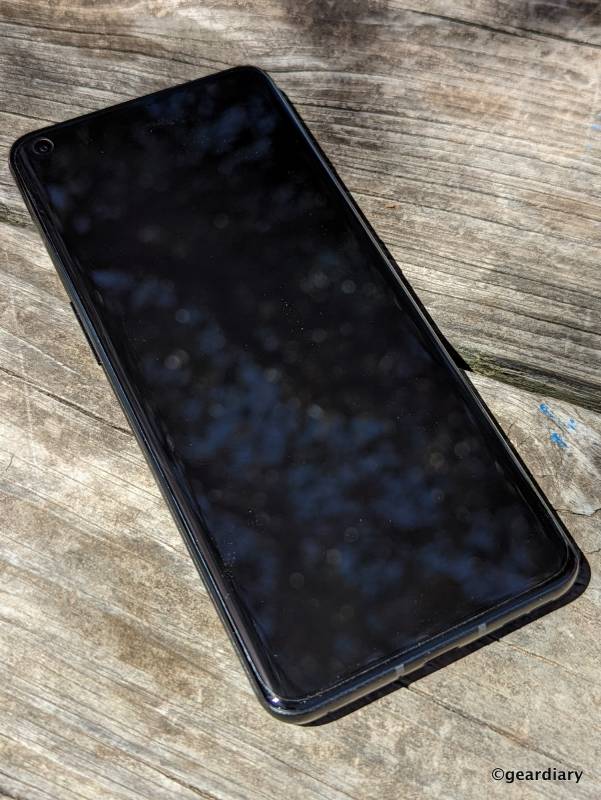
The OnePlus 10 Pro comes with a factory-installed screen protector, which I always appreciate and refuse to take for granted.
The bezels around the phone’s 20:1:9 aspect ratio display are very slim, and the punch-hole camera isn’t annoying.
There is a volume rocker on the left side of the phone.
A microphone is on the top; the 0.7″ long ear speaker is situated just above the display glass.
You’ll find the power button and the textured alert slider on the right side. The alert slider can quickly be set to silent, vibrate, or ring mode. There’s something genuinely satisfying about using a dedicated alert slider, and I am glad that OnePlus has continued to keep it.
A single nanoSIM tray, a microphone, a USB Type-C port, and a speaker are on the bottom.
The OnePlus 10 Pro has stereo speakers, so the bottom speaker will work in tandem with the ear speaker for great sound that’s plenty loud if you aren’t worried about disturbing anyone else as you play games, listen to music, or watch videos.
The OnePlus 10 Pro may look like just about any other flagship smartphone from the front, but when you flip it around, two things immediately stand out: the 10 Pro’s matte glass back is an absolute wonder, and its camera module is huge.
You’re either going to love the camera module or hate it, but there’s no doubt that it will be easily recognizable when you encounter one in the wild.
The 10 Pro’s back is made of Gorilla Glass 5 that has been buffed to the point where it is completely matte and won’t show any fingerprints, which is a very good thing as the back panel feels like sea glass that’s begging to be touched.
The OnePlus 10 Pro is available in Emerald Forest, which has an etched anti-glare rear glass that OnePlus says “sparkles when viewed from different angles,” and Volcanic Black, which, when inside or under lower light, simply appears to be a lovely matte back with a frosted finish …
… until you get it in bright sunlight, where the 10 Pro’s back takes on a nearly 3D effect due to the depth of its unexpected shimmers and sparkles.
If you aren’t a total klutz (like me), this is a phone that begs to be carried naked. The way the 10 Pro’s back feels and how it looks as it shimmers in direct sunlight makes covering it up just seem wrong. For that reason alone, I wish that OnePlus had used Gorilla Glass Victus instead of Gorilla Glass 5.
Breaking up the matte back glass’s appearance is the glossy new camera module composed of black ceramic. Ceramic is a great choice to use here; not only does its shine looks striking next to the matte glass back, but ceramic also provides better scratch resistance than glass.
The OnePlus 10 Pro’s Cameras
The OnePlus 10 Pro’s distinctive new rear camera module holds three lenses, including:
• A custom-built 48-megapixel Sony IMX789 main camera with optical image stabilization (OIS) and EIS. OnePlus says that this camera has had tuning upgrades to improve noise reduction, resolution, and dynamic range.
• A 50-megapixel Samsung ISOCELL JN1 ultra-wide camera offers a 150º field of view. Just like we saw in my recent realme GT 2 Pro review, this means that non only can you take ultra-wide shots, but you can also create fish-eye effect photos if you’re into that sort of thing.
• An 8-megapixel telephoto camera with OIS, a 3.3X optical zoom, and a 30X digital zoom with a new super-resolution algorithm that OnePlus says will improve the clarity of photos shot with the digital zoom.

The camera module also holds a microphone and an incredibly bright LED light ring.
The OnePlus 10 Pro features the second-generation Hasselblad Camera for Mobile, which we first tried last year on the OnePlus 9 Series. Updates include three new filters —Serenity, Radiance, and Emerald—calibrated by Hasselblad Ambassador Yin Chao and Hasselblad Masters winners Ben Thomas and David Peskens, respectively.
Let’s look at the available camera modes, settings, and filters.
Night: The camera does not default to this setting when it recognizes that you are in a poorly lit area; you have to select it manually, but that’s fine because you won’t always want or need this even when the lighting is poor.
When you select Night, you’ll have the option of turning Tripod Mode on or off. With Tripod Mode off, the photo is taken in roughly three seconds, which is about as long as I can hold my phone steady. In Tripod Mode, the camera assumes you have something holding it steady, so it will take a much longer exposure.
You can opt to take Night photos in aspect ratios of 1:1, 4:3, 16:9, and Full. Three zoom options are shown on the main display, including 0.6X, 1X, and 3.3X; swiping up from the options will allow you to manually select from 0.6X to 30X zoom. Filters include Motte, Vivid, Golden, Warm & Cool, Pink & Teal, and Night City.
Video: There is an “Ultra Steady” mode that you can activate if you’re holding the smartphone in hand without a tripod and shooting in 1080p. The camera can shoot at 720p (30fps and 60fps), 1080p (30fps and 60fps), 4K (30fps, 60fps, and 120fps), and 8K (24fps) videos. When shooting in 1080p (30fps), you are offered the option to add a background blur around your subject.
Zoom modes onscreen include 0.6X, 1X, and 2X, but swiping up from the options will reveal manual settings of 0.6X to 10X.
AI facial retouching is offered in 720p (30fps) and in 720p or 1080p (also at 30 fps) resolution. You can choose from video filters that include Vivid, Night City, North California, Vintage, Yummy, Night, and B&W.
I’ve noticed that if you have the camera in the video setting for more than a few minutes, the 10 Pro will start to get quite warm; I haven’t seen the camera threaten to shut down, though.
Photo: You can opt to take pictures in aspect ratios of 1:1, 4:3, 16:9, and Full. There are three pre-set zoom levels onscreen that include 0.6X, 1X, and 3.3X. Swiping up from the options reveals an onscreen zoom wheel that can shoot in increments from 0.6X to 30X. HDR can be set to off, on, or Auto; AI scene enhancement is available.
If you are in poor light, the camera will recognize that, take a moment, and adjust the exposure light exposure accordingly. Generally, I like the low-light photo results better that I get from Photo mode over those from Night mode. Here’s an example …
- Poor light picture taken in Photo mode.
- Poor light picture taken in Night mode with Tripod mode off.
If you hit the High option at the top of the display, you’ll be automatically taken to 50MP; this allows you to choose from the 0.6X or 1X zoom settings with no option to swipe up for further zoom.
Built-in filters include Radiance, Serenity, Emerald Matte, Vivid, Night City, North California, O1 through O7, P1 throughP3 (B&W filters), Blue Wave, Clean Classic, and Rosy.
You also get access to an AI beauty retouching slider in the regular camera and selfie modes. Some of the crazy retouch settings included in selfie mode will do things like improve your skin texture, resize your cheeks, eyes, nose, chin, and head, or do a quick touch-up. If you aren’t happy with one (or more) of your real-life features, the camera will fix it for your social media posts. Too bad there aren’t built-in makeup options.
Portrait: There are built-in filters that include Serenity, Natural, Sweet, Delight, Crystal, Misty, Warm, Candy, B&W, Moonrise, and Country. You can easily adjust the amount of bokeh from strong to weak in varying increments, and once again, under the selfie option, there are the same beauty retouch options offered that we saw in Photo.
And under More:
PRO: If you like to tinker, you’ll enjoy adjusting the ISO, Shutter, Exposure Value, and White Balance, with the option to use Manual or Auto Focus.
On the main display, you can choose to zoom at 1X or 2X, but you can slide up from those buttons to manually select zoom from 1X to 5X. You can also opt to shoot in JPG, RAW, and RAW+.
At the top of the display, you can manually select which camera lens you prefer to use for a particular photo.
Pano: You can use this mode to shoot panoramic photos.
Movie: This mode opens in landscape orientation, and there are onscreen zoom levels of 0.6X, 1X, and 3.3X. You can manually adjust ISO, Shutter Speed, EV, MF, and WB, all while using image stabilization. Video HDR is an option, as well as LOG, Flash, Histogram, and Grid.
Slo-Mo: You can shoot videos in 720p or 1080p, and no zoom is offered.
Time-Lapse: You can select from the onscreen options to zoom at 0.6X, 1X, or 3.3X, or swipe up and manually set your zoom from 0.6x to 10X. You can shoot your time-lapse videos in Hyperlapse, which allows you to choose a subject and always keep it within the reference frame while shooting the video. You can select either 1080 or 4K resolution.
You have the choice of five different speed options, including 10X (best for moving vehicles and pedestrians), 60X (great for flowing water), 120X (best for sunrises and sunsets), 480X (great for tracking clouds), and 960X (great for night skies).
Long Exposure: This setting gives you several options for various long exposure scenarios; choices include Moving Vehicles, Water & Clouds, and Light Painting.
Dual View Video: If you want to film yourself with the selfie camera as you react to something in front of you on the primary camera, this is the setting to use. You’ll be able to retouch your selfie shots and zoom from 1X to 2X on the main camera shots, or swipe up from those options to choose a zoom between 1X and 10X manually.
I like that you can opt for a split-screen with you on top and your subject on the bottom, but more sophisticated choices of placing your selfie in an upper right side circle or rectangle are also available.
150º: If you want to get the widest possible photo of something, you’ll have fun with the 150º fish-eye feature. You can set the camera to use HDR automatically or manually turn it on or off, and you can choose between a super-wide 150º view that fills the frame or create a circular fish-eye effect.
Filters in this setting include Radiance, Serenity, Emerald, Matte, Vivid, Night City, North California, O1 through O7, P1 through P3 (B&W choices), Blue Wave, Clean, Classic, and Rosy if you want to try some fun effects.
Tilt-Shift: You can shoot at 0.6X, 1X, and 3.3X zoom or flick your finger up and manually select from 0.6X to 30X. You can opt from aspect ratios including 1:1, 4:3, 16:9, and Full, opt to have HDR on, off, or on auto, and choose from filters that include Radiance, Serenity, Emerald, Matte, Vivid, Night City, North California, O1 through O7, P1 through P3 (B&W choices), Blue Wave, Clean, Classic, and Rosy.
You can also capture videos in Tilt-Shift mode, with the same zoom options shown in photos, with adjustable blurring and time-lapse speeds of 10X, 60X, 120X, 480X, and 960X.
XPAN: This ultra-ultra-wide mode opens in landscape orientation; you are given the option of shooting in black & white or color; on the left side, there is a slider where you can adjust the brightness from -3.0 to +3.0.
- What you see onscreen.
- The resulting photo.
Photos Taken with the OnePlus 10 Pro
Overall, I was impressed with the photos I took using the OnePlus 10 Pro. It did exceptionally well in some of the terrible light situations I threw at it; two of the pictures shown below were taken in near pitch-black rooms, so it was impressive that they were able to capture anything!
- Local favorites
- Low light
- Low light
- This room was nearly pitch black.
- This room was also nearly pitch black.
- Low light
- 0.6X Zoom
- 1X Zoom
- 3.3X Zoom
- Candids in bright sunlight
- Candids in bright sunlight
- Candids in bright sunlight
- Closeup in natural light
- Closeup in natural light
- Bright afternoon sunlight
- Bella can’t be bothered.
- Indoor light being blasted with south sun
- Propping three new philodendron plants; a closeup of their new roots
OnePlus 10 Pro Battery Life, Performance, and Daily Use
As the brand’s latest flagship, the OnePlus 10 Pro boasts a 6.7″ AMOLED display with LTPO ((low-temperature polycrystalline oxide) technology to dynamically adjust the refresh rate from 1Hz to 120Hz depending upon what’s being shown.
The point of doing this is to stretch your battery life by using a lower refresh rate when a speedier one isn’t needed, but you can also set the refresh rate to a more standard 60Hz for maximum battery conservation.
The phone comes with FHD+ (2412 x 1080p) screen resolution pre-selected, but if you don’t mind a slight battery ding, you can choose QHD+ (3216 x 1440p, 525ppi).
If you want the best of both worlds, you can set the resolution to auto-select, saving power by automatically switching resolution according to the content on your display.
The OnePlus 10 Pro is available with 8GB LPDDR5 RAM (which can be cranked up to 13GB RAM through the use of RAM expansion in the settings), and you’ll get 128GB (UFS 3.1) storage.
OnePlus says there will be a 12GB RAM with 256GB storage version available in the US, but we don’t yet know when or how much it will be.
You can also turn on Ram Boost, which will optimize RAM utilization based on what the AI has learned about how you use the phone to speed up its performance.
The OnePlus 10 Pro has the top-of-the-line Snapdragon 8 Gen 1 Mobile Platform with the X65 5G chipset and the Adreno 730 GPU. It runs Android 12 with an OxygenOS 12.1 overlay, and OnePlus has promised three major OS updates and four years of security updates.
Like the other phones that I have tried with Snapdragon 8 Gen 1, I’ve found the OnePlus 10 Pro to be fast and responsive with no noticeable lags or lock-ups; it’s a pleasure to use.
Inside, there are dual 2,500mAh batteries for a total of 5,000mAh; when it is time to charge, you’ll have the option of using the incredibly fast 65W SuperVOOC wired charging or 50W AirVOOC wireless charging.
VOOC fast charging might ring a bell; we see it in OPPO’s devices. If you’ll recall, OnePlus and OPPO merged their research and development teams, so this crossover makes sense.
You also have the option of Reverse Wireless Charging if you need to share some of that battery power.
Not surprisingly, you can unlock the phone with the usual PIN code or diagram, facial unlock, or the in-display fingerprint reader.
I was glad to see that the 10 Pro’s in-display fingerprint reader has been moved up a bit from the bottom of the display; I think enough people must have let OnePlus know that they didn’t like it being as low as it had been in the 9 series! It’s now in a much more convenient location, and its accuracy is dead-on.
Battery life has been excellent; I can easily get through a full day of use. When the chance comes, topping off is quickly done using the included 65W SuperVOOC charger and cable.
With that wired combo, you can take the OnePlus 10 Pro from 1-100% in about 35 minutes. If you have the OnePlus Warp Charge 50 Wireless Charger, you can wirelessly charge from 0 to 100% in well under an hour.
As we’ve seen with multiple generations of OnePlus devices, when you buy the unlocked version of the 10 Pro, there is no stated IP rating, but if you buy the 10 Pro from T-Mobile, it will come with an IP68 rating.
I honestly don’t think there’s any difference between the unlocked OnePlus 10 Pro and the T-Mobile 10 Pro’s hardware, but I’m not going to dunk my review sample to test that theory. Sorry!
Moving right along …
Watching videos is an absolute pleasure on the 10 Pro’s display.
While the sound through the stereo speakers is just fine, Dolby Atmos through Bluetooth headphones is where it’s at if you want the best experience. Dolby sound will kick in when you have Bluetooth headphones connected, and you can select from profiles based on your environment or a specific scenario.
If you want a dedicated swipe-down menu that offers useful, customizable content, including widgets, the weather, your favorite apps, photos, etc., you’ll like the new OnePlus Shelf; it’s accessed by swiping down from the upper right.
Swiping down from the upper left of the display will show your notifications and quick settings; it might take a minute before you realize that your swiping needs to be more purposeful. If you get frustrated with accidental Shelf openings when you want Notifications, it’s easy enough to turn that setting off.
So, Should You Buy the OnePlus 10 Pro?
In the 10 Pro, OnePlus has provided a reasonably-priced flagship that is undoubtedly one of the best-looking and best performing phones of 2022. Should you spring for one?
If you already have a OnePlus 9 series phone, for instance, there’s not really much of a compelling reason to upgrade unless you just want the latest model.
If you’re still rocking the OnePlus 8T (or an even older model) and you’re a T-Mobile or Verizon customer, then the OnePlus 10 Pro seems like an obvious choice.
If you aren’t a T-Mobile or Verizon customer, and you’re satisfied with the 4G/LTE speeds in your area — or if the 5G speeds in your area aren’t that much better than 4G/LTE seeds, then the OnePlus 10 Pro is an excellent choice.
The OnePlus 10 Pro retails for $899.99; it is available directly from the manufacturer, T-Mobile, and Amazon starting on April 14th.
Source: Manufacturer supplied review sample
What I Like: Refined hardware and design that looks and feels great; Matte finish on rear glass isn’t a fingerprint magnet; Reasonably priced; Gorgeous 1Hz to 120Hz adaptive display; Excellent performance with top-of-the-line Snapdragon processor, RAM Boost, and RAM Expansion up to 13GB; Hasselblad-tuned cameras offer lots of fun options and tweaks; Camera does surprisingly well in poor light even in Photo mode vs. Night; OnePlus is promising three OS upgrades and four years of security updates; Solid 4G/LTE with VoLTE on AT&T; T-Mobile version has IP68 dust and water-proof rating; Includes a 65W charger in the box
What Needs Improvement: T-Mobile and Verizon are the only US carriers offering 5G support; IP dust and water resistance are not stated for the unlocked version
UPDATE 04/14/22: We’ve received word that the OnePlus 10 Pro is now certified on Verizon’s 5G network, and this review has been updated to reflect that.









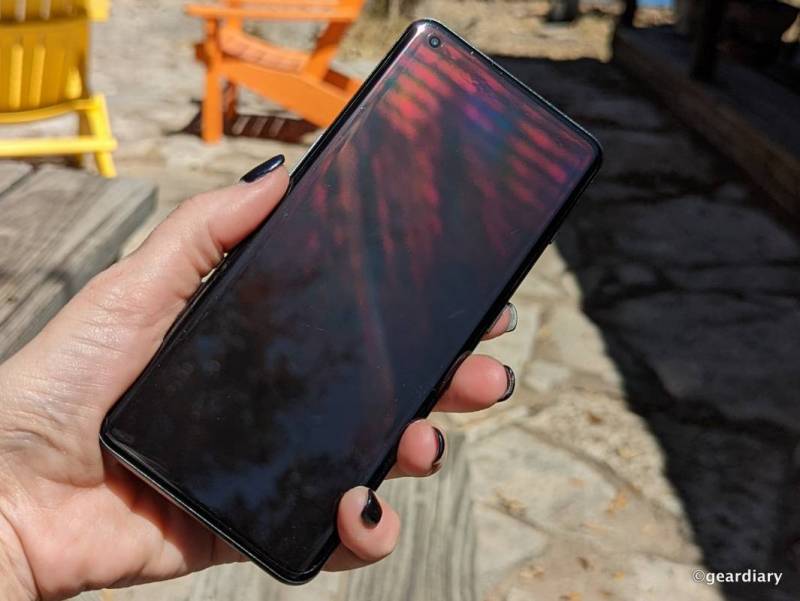
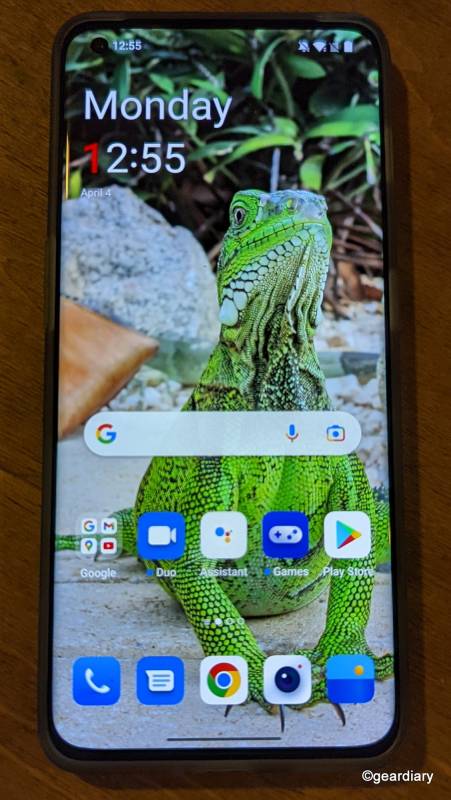
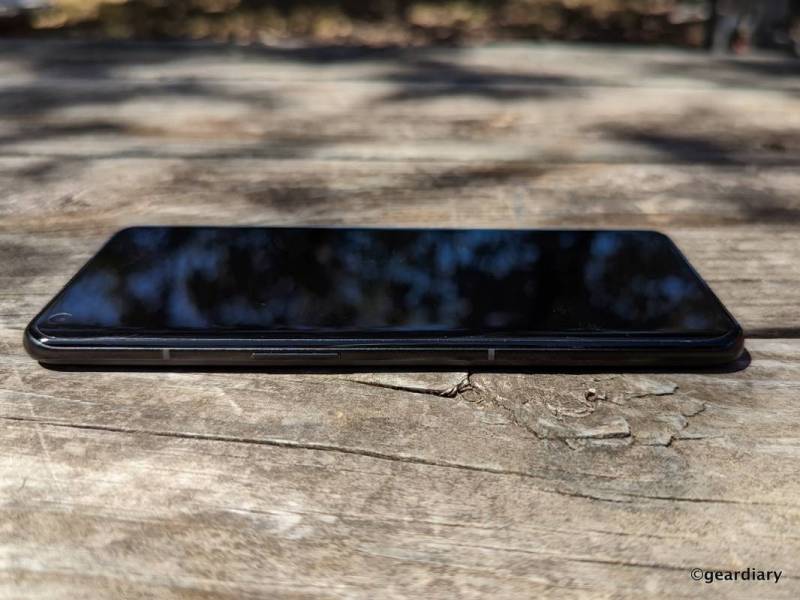
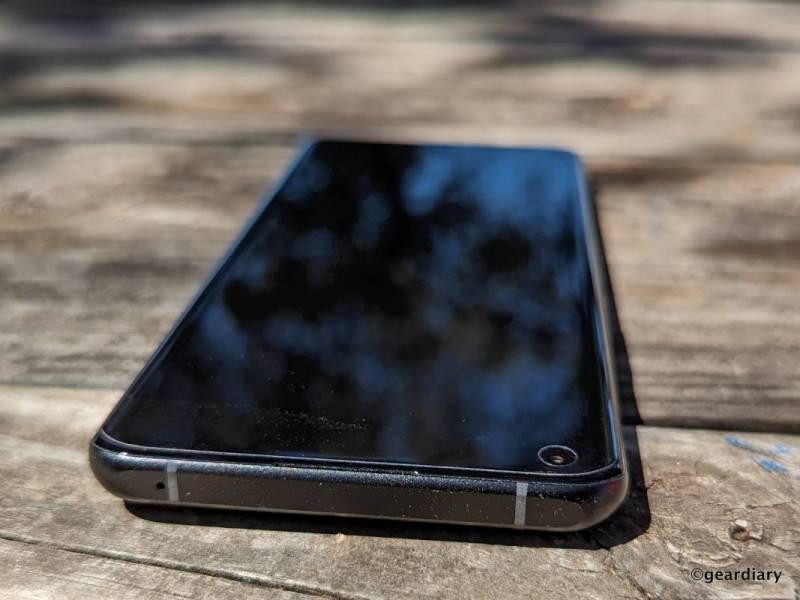

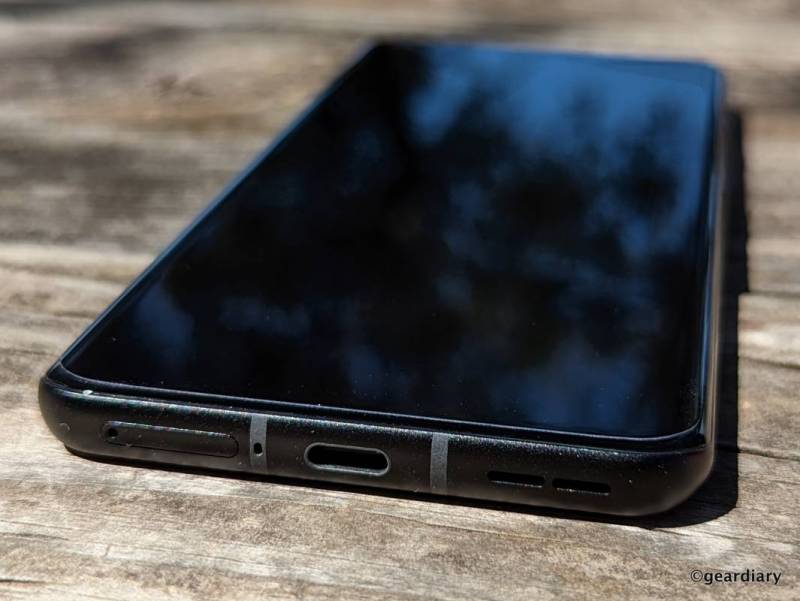
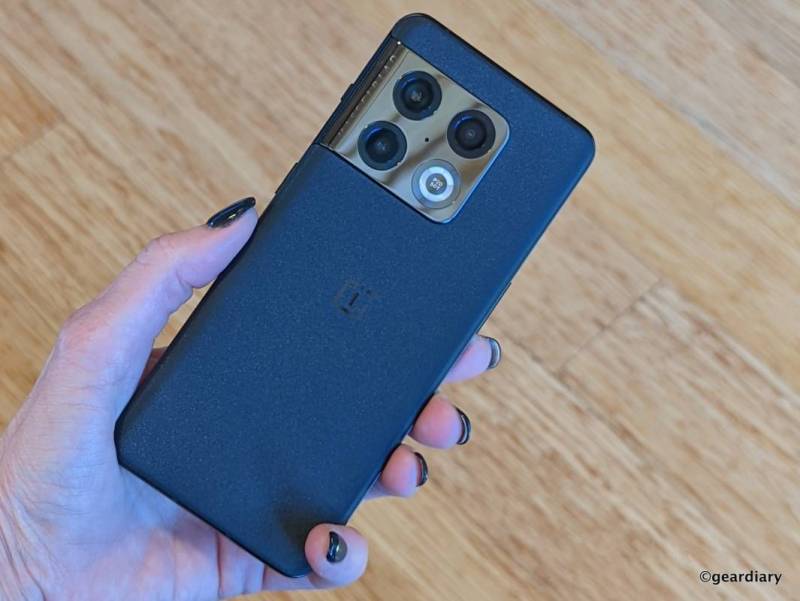






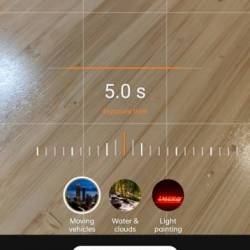




















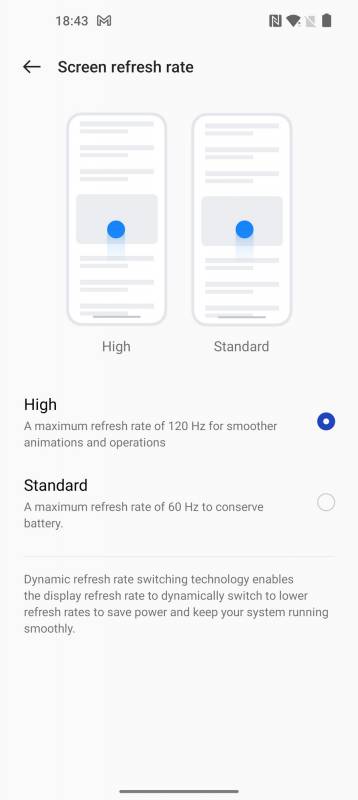


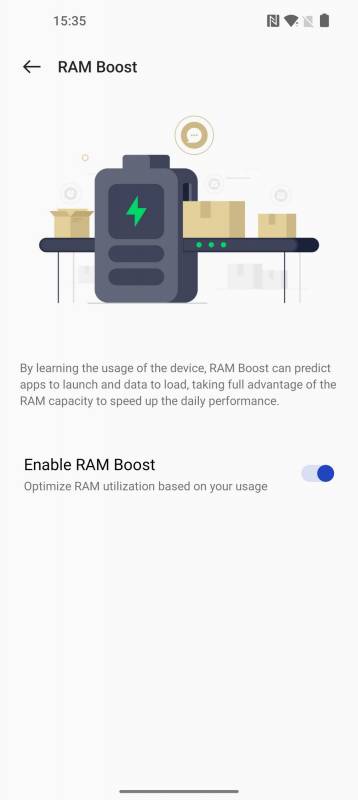
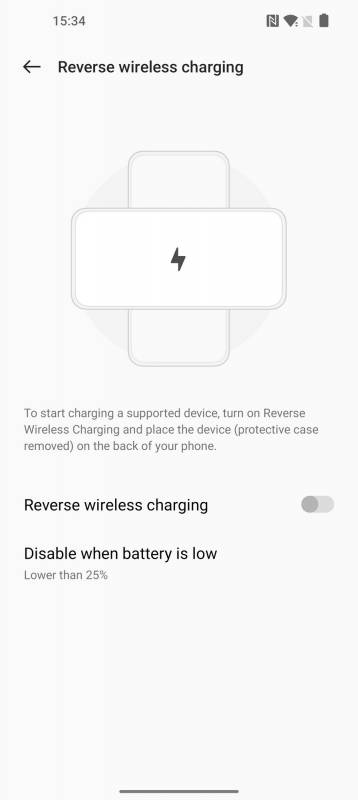
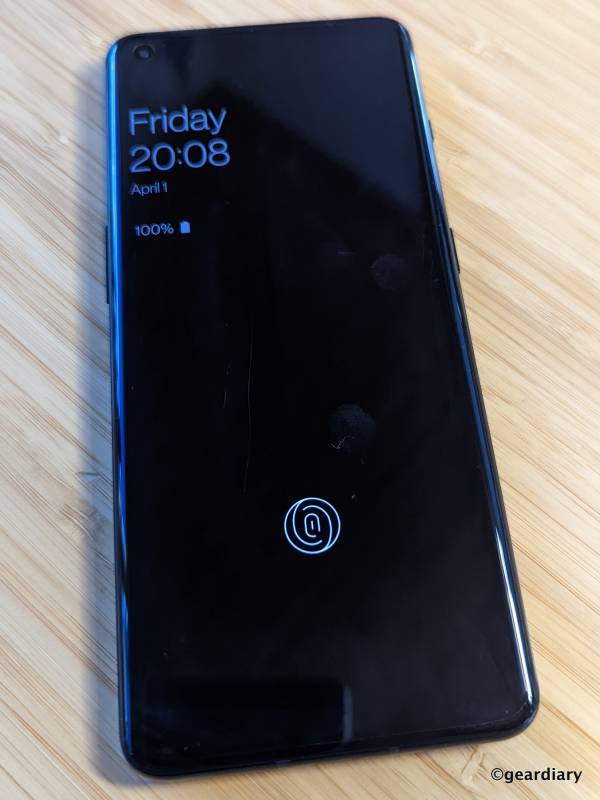



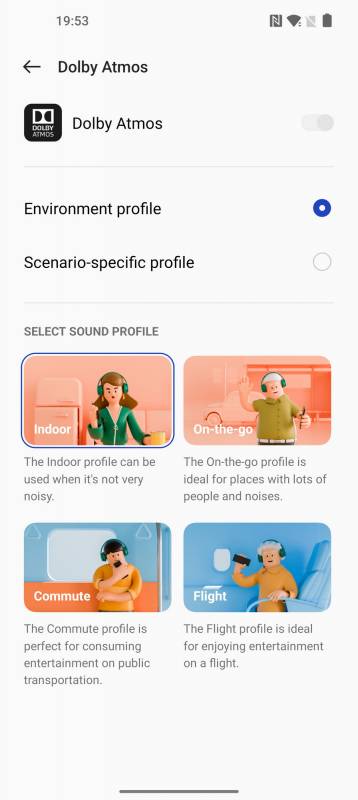
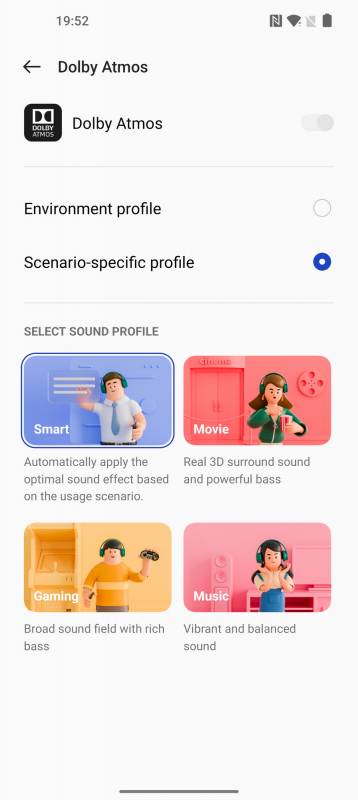


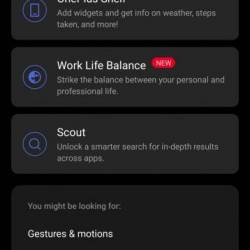
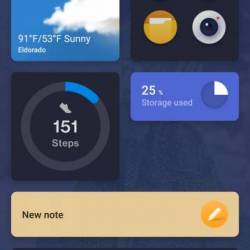
The cameras are pretty impressive. From the user’s point of view, is there any practical difference between having 2 2500 mAh batteries or, say, a single 5000 mAh battery?